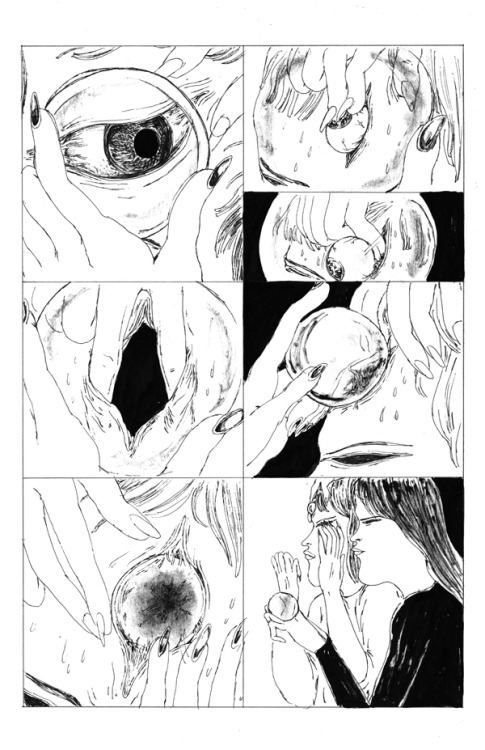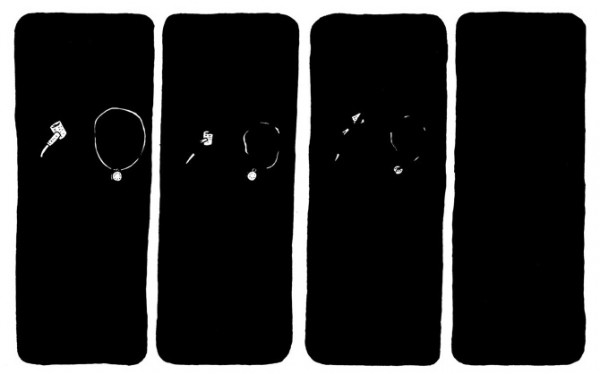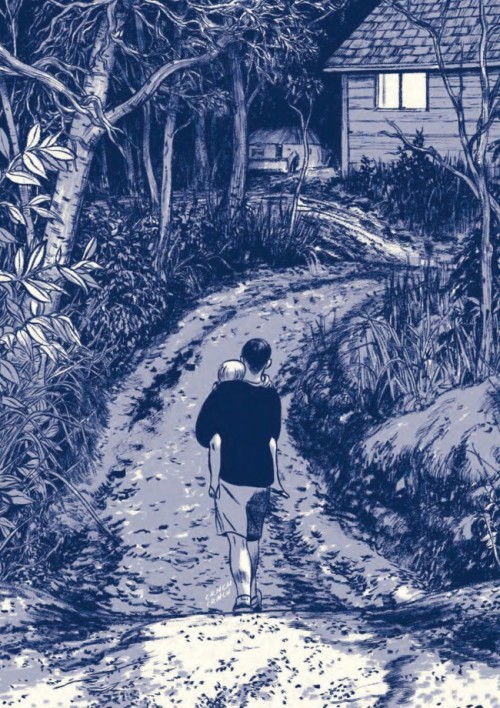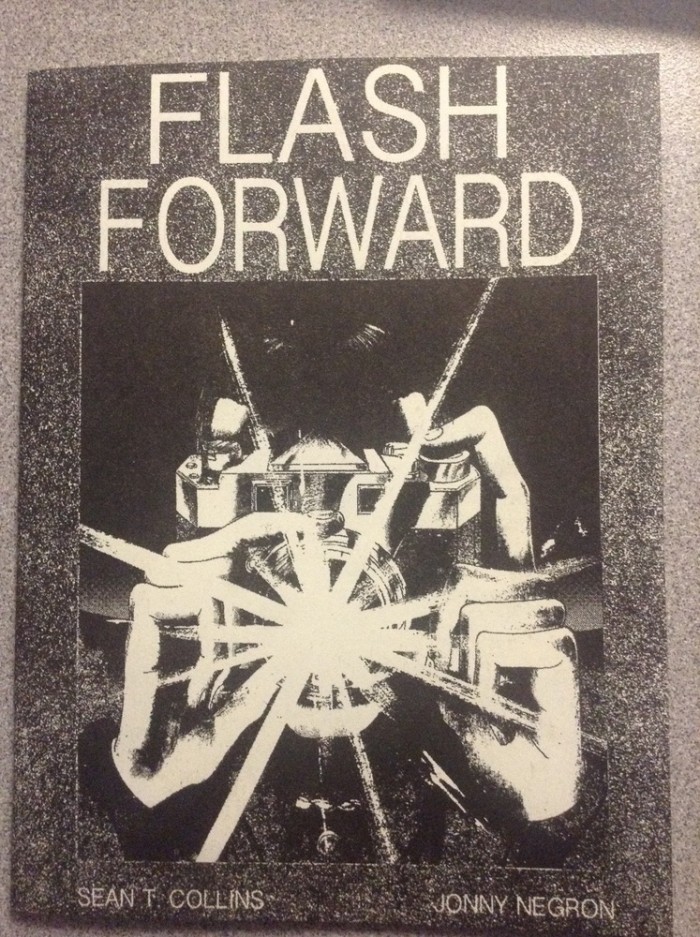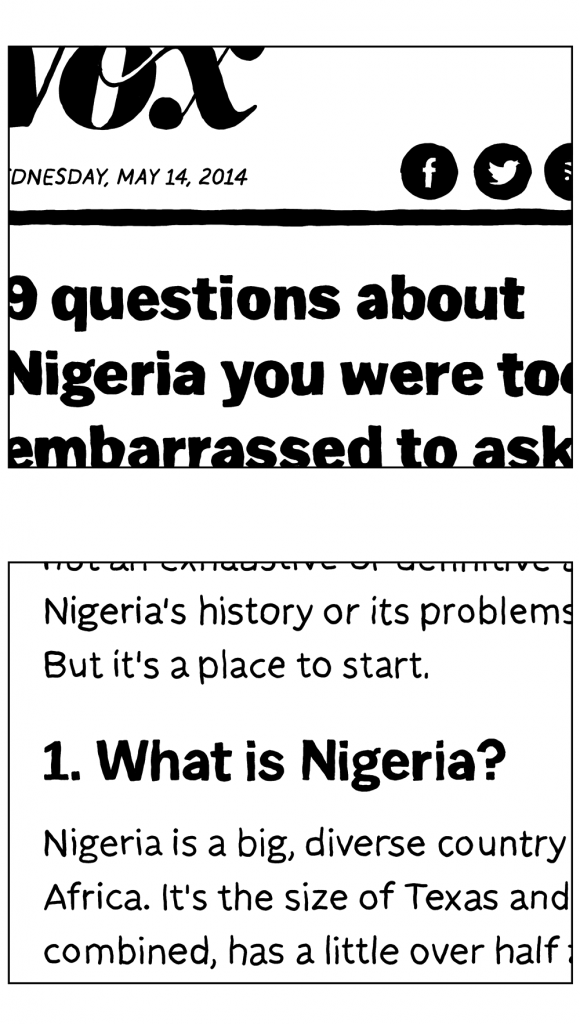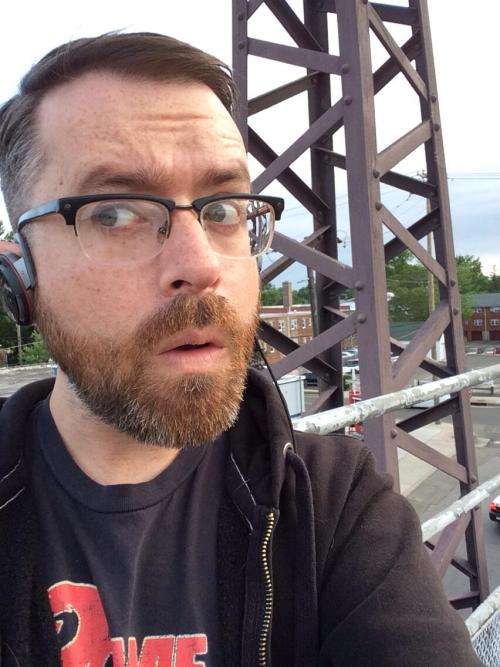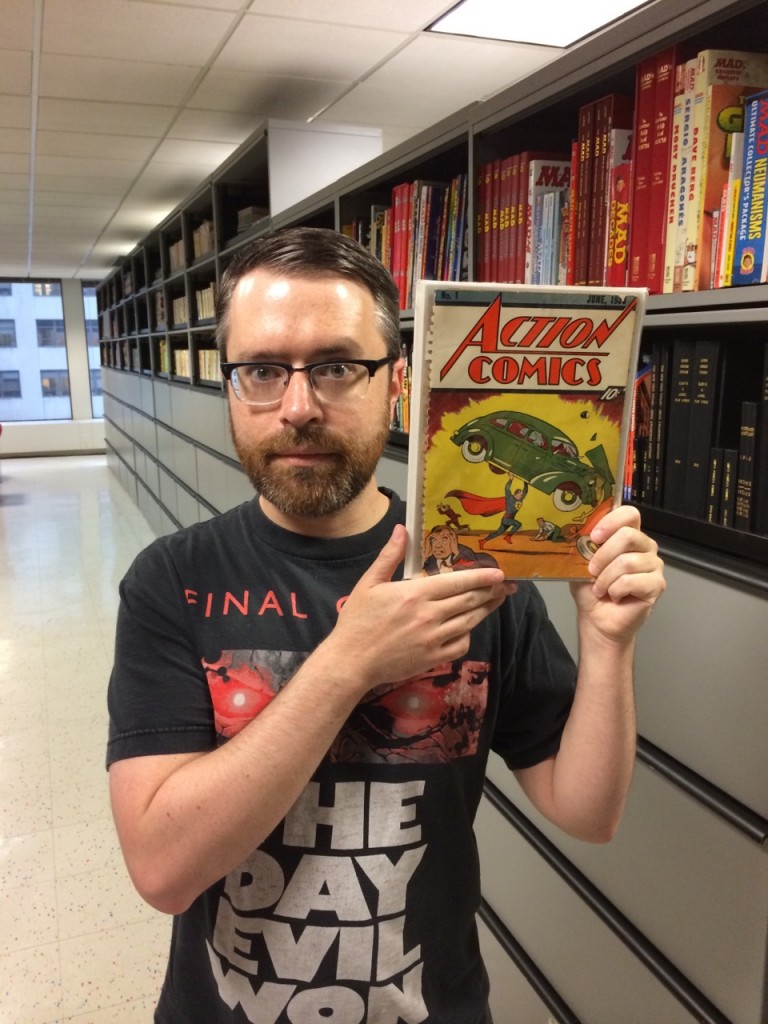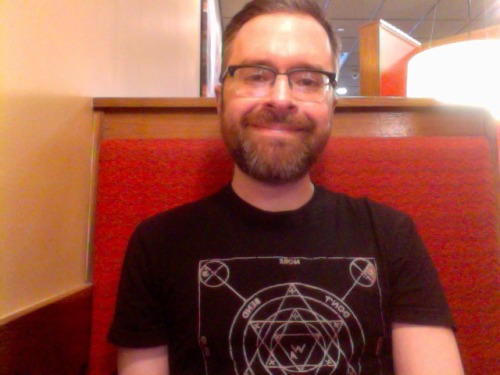Posts Tagged ‘comics’
Comics Time: Alien Invasion III
August 14, 2014True, in a way, to its title, Lauren “Lala” Albert’s Alien Invasion III has two primary concerns: aliens and invasiveness. The former are presented in the fashion that has become Albert’s trademark as an artist working with science-fictional imagery in an underground context — otherworldly and elfin, their ubiquitous third eyes a collective locus of mystical enlightenment, erotic fascination, and viscous physicality all at once. The invasions are varied. Aliens visit Earth, humans visit other worlds, humans and aliens travel between worlds together. Alien biology is probed by a human performing an autopsy, explored by two aliens in a body-modification ritual with romantic undertones, inserted unexpectedly and forcibly into an unsuspecting human’s more familiar body. In all four cases the theme is intimacy, invited or not.
I reviewed Alien Invasion III by Lauren Albert (aka Lala Albert) for The Comics Journal.
How Teenage Mutant Ninja Turtles went from comics in-joke to cowabunga blockbuster
August 14, 2014Most of the action-figure/kids’-cartoon juggernauts of the Eighties were developed the old-fashioned way: by corporations. He-Man and the Masters of the Universe began in the design department of toy behemoth Mattel. Its rival Hasbro teamed up with Marvel Comics to revive its old G.I. Joe concept, this time making its toy soldiers the same size as the smash-hit Star Wars action figures to which Mattel had passed up the rights several years earlier, with their “Real American Hero” relaunch. The Hasbro/Marvel team-up found similar success when it rebranded several lines of robot toys Hasbro had licensed from Japanese toy company Takara as the Transformers.
By contrast, the Turtles literally started out as a joke. Co-creators Kevin Eastman and Peter Laird were comic-artist wannabes when they spent a November 1983 evening doodling the masked, weaponized reptiles to entertain themselves. Each adjective in Turtles‘ title represented a hot superhero-comic trend at the time — mutants were the stars of Marvel’s Uncanny X-Men; DC’s New Teen Titans had teenage protagonists; and future Sin City impresario Frank Miller had stuffed his groundbreaking run on Daredevil full of ninjas. By throwing it all together atop a funny-animal framework — which, from Carl Barks’ Donald Duck to Steve Gerber’s Howard the Duck, had long been a route to comic-book gold — Eastman and Laird simply obeyed the Spinal Tap doctrine of cranking it to eleven.
This here is a snippet from the history of the Teenage Mutant Ninja Turtles I wrote for Rolling Stone. The gist is that the Turtles began as a literal joke shared by creators Kevin Eastman and Peter Laird, and came to prominence as a comic that existed halfway between Frank Miller parody and Frank Miller homage; it was only when Eastman & Laird hooked up with a toy company that hooked up with an animation studio — i.e. the same basic process that birthed He-Man, G.I. Joe, and the Transformers — that it became the durable pop-culture phenomenon it is today.
I got to work in all kinds of fun factoids — the “black-and-white boom” that followed TMNT’s success in comic shops, the bonafide alternative-comics ventures funded by Eastman (Tundra) and Laird (the Xeric Grant) with their Turtle fortunes, “Turtle Power” going to the top of the pop charts in the UK. I hope you enjoy it!
Comics Time: Danny Boy
August 8, 2014…the ending is otherwise the strongest section of the comic, the one place where Danny Boy takes on a life of its own. It does so in death. In the end, father and son are buried side by side, first their bones and then even their coffins breaking down as the dark earth reclaims them. In the end, the totemistic pipe and locket that Faret had used as shorthand for each member of the pair are all that remain, and they too are disintegrated and consumed before the final black panel. A realist might question the staying power of a corncob pipe in a grave, while a reader partial to extremes might miss a full-fledged depiction of dead bodies rotting away into nothingness (admittedly this is where my sympathies lie), but both critiques are superfluous to the sequence’s purpose, if not its power. In these final pages, Faret unearths an unspoken element of “Danny Boy” and puts it on display: The song’s final line is “And I shall sleep in peace until you come to me,” but of course at that point in the song the child has already returned, is in fact kneeling on the grave. It’s death the parent is looking forward to sharing with his child, because only then will their reunion be complete. Faret shows what that would look like, taking the original and adding a stanza of her own.
Those final pages present a potentially rewarding path for Faret to follow as an interpreter of existing stories. It reflects the same sensibility on display in, say, her luminous, horror-tinged scratchboardillustrations for Arthur Miller’s The Crucible. Though the whole point of Miller’s witch-hunt parable is that the thing was bunkum, Faret casts her cast of goodwives in a seemingly supernatural light, suggesting that terrible forces and tremendous powers were in play here — just not in the way the persecutors believed. Neither here nor in the end of Danny Boy is Faret indulging in the aforementioned glurge, lacing contemporary mores into past events in order to make readers feel good about their unearned ethical superiority (though she’s not entirely immune to this temptation); rather, she’s tapping into ideas and sentiments present in the characters and giving them freedom to manifest themselves in ways the characters could never do. Danny Boy may be a failed experiment, but in conducting it Faret has collected data that could well yield happier results a season or two down the line.
I reviewed Danny Boy by Kjersti Faret for The Comics Journal.
Comics Time: Configurations
July 30, 2014I hesitate to use the formulation “more than just a comic” in describing “Configurations”, the recent webcomic series Aidan Koch published through TCJ contributor Frank Santoro’s Comics Workbook tumblr. Comics are whatever you put into them, and “Configurations,” certainly a comic, puts in plenty. But it feels less like a strip you read and more like a participatory event. It’s the rare experimental work that makes you feel as though you’re there in the lab with its creator, conducting that experiment yourself.
The Rise of ‘Guardians of the Galaxy”s Rocket Raccoon
July 30, 2014“You can only take these characters so far before it gets ridiculous,” Gunn admits. “Honestly, some of the latest superhero movies take themselves so seriously, they feel like a joke. This desperate, angsty need for ‘coolness’ is sort of pathetic. Guardians is a big reaction against that.” Will the grim-and-gritty-loving fanboys go along? Gunn laughs. “Who the hell knows?”
Comics Time: This One Summer
July 24, 2014At the beginning of This One Summer, its main character, Rose, splashes down into her bed, holding her nose and falling backwards as if leaping off a dock into the lake nearby. At the end she and a friend dig a hole in the beach big enough to contain her, and she lies in it, posing for her last picture of the summer — this is how she wants to remember it. In between, nature, as drawn with preposterous skill by Jillian Tamaki, proves capable of enveloping her without her help. Big summer-night skies, full of stars and moonlight. Bright summer sun, hanging overhead like it will never set again. Wet, heavy summer rain, seemingly just as endless, pouring into puddles drop after drop. Trees and vines and bushes and grass and undergrowth, verdant, overripe to the point of hysteria. The lake, which is alternately drawn dominating a spread vertically like a monolith, suspending the joyous bodies of tumbling teenagers in its inviting murk, and enveloping them like a sunlit shroud when they no longer wish to be found. Against this brush-stroke backdrop stand Rose and the other impeccably cartooned characters, whose stylized simplicity (relatively speaking; no sense that these are real people is lost) when juxtaposed with those wall-of-sound environments makes them feel like inner tubes bobbing in the water, or stones tossed in it. Immersion is This One Summer‘s strength, and it works alarmingly well for the story that cousin-collaborators Jillian Tamaki and Mariko Tamaki are telling. It’s a young-adult graphic novel, and young adults are constantly tossed into new circumstances by forces beyond their control, from puberty to parents. Out of their depth, do they sink or swim?
I reviewed This One Summer by Jillian Tamaki and Mariko Tamaki for The Comics Journal.
Comics Time: How to Be Happy
July 24, 2014The first moment — but certainly not the last — that made me stop reading How to Be Happy, turn back the pages, and immediately re-read them came early. “In Our Eden”, the lead-off piece in Eleanor Davis’s masterful new collection of short stories, concerns a back-to-nature commune driven to dissent and dissolution by its founder’s purity of vision. Some members chafe at the convention by which every man is called Adam, every woman Eve. Others fall away when the leader, a towering and barrel-chested figure with a ferocious black beard like something out of a David B. comic, takes away all of their prefab tools. The rest depart when he insists they neither farm nor kill for food, literalizing and reversing the Fall’s allegory of humanity’s move from hunter-gatherer to agrarian societies. At last it’s just this one Adam and the Eve he loves. By the next time we see them, Adam’s gargantuan physique has been pared away, his ribs visible, his nose reddened for a sickly effect, demonstrating Davis’s remarkable ability to wring detail and expressive power out of the simple color-block style of the piece. He comes across Eve, nude and stork-skinny, washing her long hair in a river. He goes to her, nude himself. “I’m ready for the bliss to come,” he says right to us in one of the recurring panels of first-person narration that have been peppered through the comic. They embrace. “I’m ready for the weight to lift.” They kiss.
I turned the page, curious as to how the story would end. Some final irony? Some subtle but biting indictment of utopian folly? A widening of the view to deny the lovers centrality in their world? None of the above: the story had already ended. The build-up I’d read into it — a crescendo of extremism that would end with Adam’s hubris exposed and exploited — didn’t exist. The easy climax, the stacked-deck scenario so common in stories about true believers in which author and audience get over at the expense of the characters when the latter are made to look foolish for foibles the former recognize instantly, never comes. The climax had come two pages before, when I turned from one page to the next and reached a splash-page image of the moment when Eve turns to see her Adam. This moment of connection is the story’s resolution. The use of Adam and Eve’s human bodies to communicate to one another, to seek the bliss that’s coming, to lift that weight, is the image Davis wants us to leave with. No moral, no punchline, no muted epiphany — discarded along with all the other distractions, they leave only Edenic bliss behind.
I reviewed Eleanor Davis’s masterful comics collection How to Be Happy for The Comics Journal.
Comics Time: Sorry Kid
June 26, 2014Sorry Kid folds out like a 22×17 broadsheet. When examined closely, it reveals itself to be two 11×17 pages, their surface murky with black xerox ink, joined together by sparkly rainbow-silver tape. This juxtaposition in its construction encapsulates the eight-page whole, which sees Clark alternate heartrending grappling with the overpowering grief of her father’s death and small welcome gestures in the direction of comfort.
All of the text is borrowed from apparently much-loved sources: Inside, writer Hélène Cixous’s novel on this theme; Ursula K. Le Guin’s fantasy classic The Farthest Shore; the Cocteau Twins song “Know Who You Are at Any Age”. It’s a tacit acknowledgement that recognition of your pain in painful work is often as comforting as can be.
I reviewed my first comic in ages, Sorry Kid by Katrina Silander Clark, for The Comics Journal.
FLASH FORWARD back in stock
June 23, 2014“What Is Nigeria?”
June 3, 2014Colin Panetta and I made a comic called “What Is Nigeria?”, inspired by this vox.com article by Max Fisher.
STC @ CAKE
May 29, 2014Come see me at CAKE, the Chicago Alternative Comics Expo (the “k” is silent, and invisible), this weekend! I’ll sporadically be at table 68A with Julia Gfrörer, hawking our Edgar Allan Poe porn comic In Pace Requiescat and potentially Flash Forward by me and Jonny Negron too, and I look like this.
I should not have been trusted with this
May 16, 2014Sean & Julia on Poe & Porn
May 5, 2014What inspired you to make this Poe Porn (lol)?
Sean: Julia and I have a lot in common, and one of those things happened to be a fascination with this particular Poe story, which we’d both read at an impressionable age.
Julia: I felt like Sean’s script was such an effective interpolation of the original story because in a sense it wasn’t radical at all, its constituent elements are entirely native to the source material. There are hints of regret, of reluctance, almost tenderness, supporting the maniacal sadism. The meticulousness with which Montresor inflicts the final act of cruelty on his friend already carries an erotic undertone–maybe not all readers experience that, but Sean and I didn’t invent it.
Sean: In “The Cask of Amontillado” I recognized a link between the genres of horror and pornography. Both frequently rely on a sense of certainty for their visceral emotional impact: When you begin to read or watch a horror story, you know that a terrible thing will happen, and frequently so does the character to whom it’s going to happen. In pornography, as in sex generally, you know that when your partner begins touching you, you have entered into a process that will end with you briefly losing control of your own body, unable to think of anything but the pleasure your partner is effectively forcing you to experience at the expense of everything else. In both cases that certainty is magnetic to minds trapped in our unforgivingly inconstant and unpredictable world. Dread and eroticism are two sides of the same coin neither of us can stop flipping in the art we make or consume.
Julia: Right, I rarely respond to a sex scene that doesn’t have some foreboding attached to it. The sense that the world has stopped and what’s happening right now is the only thing that matters or exists is romantic, but it also feels like something on the verge of panic.
Sean: “The Cask of Amontillado” and Montresor’s revenge scheme both depend on that certainty — on Montresor letting Fortunato know exactly what’s happening to him, and exactly what will continue to happen to him until he dies. There just came a day when I wondered what would happen if Montresor’s mental circuit overloaded and that horrific mastery over another human being became erotic mastery over the same person. This was the result.
We hope to do more Poe-nography together, actually. We’ve been talking about “The Fall of the House of Usher.”
Julia: “The Pit and the Pendulum” seemed a little on the nose.
—Glory Hole In One: A NSFW Comic Book Review & Interview | Slutist
The marvelous writer/musician/dominatrix Hether Fortune interviewed me and Julia Gfrörer about In Pace Requiescat, our pornographic adaptation of/extrapolation from “The Cask of Amontillado” by Edgar Allan Poe, for Slutist.You can buy the comic here.
A May Day thought
May 1, 2014Respecting creators’ rights is not about reasserting the magical aura of the Artist in opposition to the hoi polloi, it’s about defending the relationship between worker and the work produced. Creators’ rights are labor rights.
HBO, Marvel, and “The New Canon”
April 24, 2014I’m so wrong, but not in the way I might have expected. My students taught me that. They watch Netflix, and they watch it hard. They watch it at the end of the night to wind down from studying, they watch it when they come home tipsy, they binge it on a lazy Saturday afternoon. Most use their family’s subscription; others filch passwords from friends. It’s so widely used that when I told my Mad Men class that their only text for the class was a streaming subscription, only one student had to acquire one. (I realize we’re talking about students at a liberal arts college, but I encountered the same levels of access at state universities. As for other populations, I really don’t know, because Netflix won’t tell me (or anyone) who’s using it.
Some students use Hulu, but never Hulu Plus — when it comes to network shows and keeping current, they just don’t care. For some super buzzy shows, like Game of Thrones and Girls, they pirate or find illegal streams. But as far as I can tell, the general sentiment goes something like this: if it’s not on Netflix, why bother?
It’s a sentiment dictated by economics (a season of a TV show on iTunes = at least 48 beers) and time. Let’s say you want to watch a season of Pretty Little Liars. You have three options:
1) BitTorrent it and risk receiving a very stern cease-and-desist letter from either the school or your cable provider. Unless you can find a torrent of the entire season, you’ll have to wait for each episode to download. What do you do when it’s 1:30 am and you want a new episode now?
2) Find sketchy, poor quality online streams that may or may not infect your computer with a porn virus (plus you have to find individual stable streams for 22 episodes)
or
3) Watch it on Netflix in beautiful, legal HD, with each episode leading seamlessly into the next. You can watch it on your phone, your tablet, your computer (or your television, if it’s equipped); even if you move from device to device, it picks up right where you stopped.
It’s everything an overstressed yet media-hungry millennial could desire. And it’s not just millennials: I know more and more adults and parents who’ve cut the cable cord and acquired similar practices, mostly because they have no idea how to pirate and they only really want to watch about a dozen hours of (non-sports) television a month (who are these people, and what do they do after 8 pm every day?)
Through this reliance on Netflix, I’ve seen a new television pantheon begin to take form: there’s what’s streaming on Netflix, and then there’s everything else.
When I ask a student what they’re watching, the answers are varied: Friday Night Lights, Scandal, It’s Always Sunny, The League, Breaking Bad, Luther, Downton Abbey, Sherlock, Arrested Development, The Walking Dead, Pretty Little Liars, Weeds, Freaks & Geeks, The L Word, Twin Peaks, Archer, Louie, Portlandia. What all these shows have in common, however, is that they’re all available, in full, on Netflix.
Things that they haven’t watched? The Wire. Deadwood. Veronica Mars, Rome, Six Feet Under, The Sopranos.Even Sex in the City.
It’s not that they don’t want to watch these shows — it’s that with so much out there, including so much so-called “quality” programs, such as Twin Peaks and Freaks & Geeks, to catch up on, why watch something that’s not on Netflix? Why work that hard when there’s something this easy — and arguably just as good or important — right in front of you?
The split between Netflix and non-Netflix shows also dictates which shows can/still function as points of collective meaning. Talk to a group of 30-somethings today, and you can reference Tony Soprano and his various life decisions all day — in no small part because the viewing of The Sopranos was facilitated by DVD culture. Today, my students know the name and little else. I can’t make “cocksucker” Deadwood jokes (maybe I shouldn’t anyway?); I can’t use Veronica Mars as an example of neo-noir; I can’t reference the effectiveness of montage at finishing a series (Six Feet Under). These shows, arguably some of the most influential of the last decade, can’t be teaching tools unless I screen seasons of them for my students myself.
—Anne Helen Petersen, “The New Canon,” LA Review of Books
This absolutely fascinating essay makes the persuasive argument that HBO’s absence from Netflix, the television viewing mechanism of choice for a generation, means what those of us who are slightly older consider key, canonical shows simply aren’t getting watched anymore. It makes a great deal of sense: My own love of The Sopranos, Deadwood, and The Wire was enabled by DVDs, which were at the time the easiest, quickest, cheapest technology for viewing. Now that’s streaming, and those shows didn’t (until the recent Amazon Prime deal anyway) stream without a prohibitively expensive HBO-inclusive cable subscription, and they still don’t stream on the service of many people’s choice, so there’s a whole lot of potential Seans out there who aren’t ever gonna come across these shows. Technology — DVDs, DVRs, Netflix, streaming, even just the proliferation of cable channels and the concomitant need for more programming — played such a crucial role in the creation of the New Golden Age; it’s engrossing to see how it will help transform it and alter our perceptions of it in retrospect as well.
I should add that one of the reasons this article struck me so is that many of its lessons apply to another area of interest for me: Marvel Comics’ mismanagement of its backlist. Very quickly, even after its purchase by Disney, the company is still run by the man who bought it in, and brought it out of, bankruptcy in the late ’90s, Isaac Perlmutter. In many ways he still runs the place like the doors will close at any moment. Sometimes this makes headlines, as when the stars of Marvel’s films band together to demand higher wages; sometimes it’s fodder for jokes, like how Marvel’s publishing wing’s office space has a grand total of one available restroom per gender for hundreds of employees.
But it has a real impact too, in that books are constantly allowed to go out of print rather than commit to the cost of keeping them in print and available to retailers. Marvel makes an end-run around this by continuously repackaging and reprinting, but the net effect is that if you wanted to purchase a seminal, artform-altering run on a Marvel series — the Stan Lee/Jack Kirby Fantastic Four in its entirety, say, or the Stan Lee/Steve Ditko/John Romita Sr. Amazing Spider-Man — this is literally impossible to just hop on Amazon or go to your comic shop and do. At best, you’ll be able to cobble together a collection with different trade dresses, at different sizes, with different cover stock. In many cases you’ll just give up.
This costs Marvel money, obviously — I’d have plunked down $100 or whatever to buy all the Lee/Ditko Spidey and Lee/Kirby FF in one fell swoop years and years ago, if I could have. But it also costs them in terms of legacy — in terms of how readers and critics alike view their output. Compared to their nearest competitor, DC Comics, Marvel’s ’80s output never reached the heights of DC’s best work of the era, your Watchmen and Dark Knight Returns and Batman: Year One. But DC is equally adept at maintaining and selling B- and C-level books like Kingdom Come or the various Jeph Loeb Batman collections that Marvel can easily match or beat with things like Marvels or a solid Dark Phoenix Saga collection or Spider-Man: Kraven’s Last Hunt or even Daredevil: Born Again from the Year One creative team of Frank Miller and David Mazzucchelli. But these titles are available sporadically at best, and have been in and out of print so many times that you’d be hard pressed to find two copies that even look alike. Compare that to how consistent, say, Watchmen has looked on store shelves for nearly three decades now.
Moreover, in terms of its 1960s Silver Age material, Marvel absolutely crushes DC. Artistically, Jack Kirby and Steve Ditko were stylistic innovators who continue to influence the totality of the artform today, not just superhero comics but alternative and art comics as well. Narratively, too, ’60s Marvel basically invented the shared-universe template so much popular fiction follows today — sure, Batman and Superman teamed up from time to time, but the events that befell the Fantastic Four could change what happened to Iron Man or Spider-Man or whoever else. What’s more, those comics had a genuine sense of stakes their DC counterparts sorely lacked; I can’t tell you what an eye-opener it was to interview people as disparate as Gary Groth and Walt Simonson for the oral history of Marvel I did for Maxim a few years ago and hear that one of the things that impressed them about Marvel as kids was simply the fact that these superheroes actually got in fights. Such a basic component of how these stories are told to this day didn’t even exist before Lee, Kirby, Ditko et al did it. Finally, unlike DC, which has rebooted nearly half a dozen times, all those classic Marvel stories are still in continuity — they matter to the stories of those characters to this day. In all these respects those comics are valuable and readable to today’s readers; sure, they’re dated, but so is The Prisoner and The Twilight Zone, you know? A nice, uniformly designed collection of those runs would be invaluable to “fans,” to scholars, to cartoonists, to libraries, you name it. But no such collection exists. It’s not just money that’s left on the table, it’s the perception that the work is valuable and alive. And perhaps HBO, to a lesser but still significant degree, is weathering that exact same loss.
Study Group Magazine #3D
April 21, 2014Sexual Harassment in Comics
April 16, 2014Writer and editor Janelle Asselin has created an anonymous survey regarding sexual harassment in comics, and I think it’s very important that people involved in alternative/art comics are represented. We read different comics, go to different cons, shop at different stores, work with different publishers, move in different social circles, and those realities should be reflected. Please take the two minutes it takes to fill this out.
STC @ MoCCA
April 3, 2014Come see this smiling mug in person at the MoCCA Arts Fest at the Armory in NYC, this Saturday and Sunday from 11a-6p. I’ll either be circulating or making a nuisance of myself near Julia Gfrörer at table G4, so make sure to grab me and say hi if you see me. It’s an alternative-comics convention, so I’ll no doubt be hankering to discuss the membership of the ideal Kingsguard.
Hellboy/BPRD/Mignolaverse Reading Order
January 29, 2014Every once in a while I like to put together a list of all of Mike Mignola, John Arcudi, and company’s Hellboy/B.P.R.D./Abe Sapien/Lobster Johnson/Witchfinder/etc. trade paperbacks in the order one should read them. Generally that means “in the order they came out,” though there’s the occasional exception (eg. the most recent Abe Sapien trade came out before the most recent BPRD: Hell on Earth trade but should be read after it). Here’s what I’ve got at the moment.
1. Hellboy: Seed of Destruction
2. Hellboy: Wake the Devil
3. Hellboy: The Chained Coffin and Others
4. Hellboy: The Right HAnd of Doom
5. Hellboy: Conqueror Worm
6. BPRD: Hollow Earth & Other Stories
7. Hellboy: Weird Tales Vol. 1
8. BPRD: The Soul of Venice & Other Stories
9. Hellboy: Weird Tales. Vol. 2
10. BPRD: Plague of Frogs
11. BPRD: The Dead
12. Hellboy: Strange Places
13. BPRD: The Black Flame
14. BPRD: The Universal Machine
15. Hellboy: The Troll Witch and Others
16. BPRD: Garden of Souls
17. BPRD: Killing Ground
18. Lobster Johnson: The Iron Prometheus
19. Hellboy: Darkness Calls
20. Abe Sapien: The Drowning
21. BPRD: 1946
22. BPRD: The Warning
23. BPRD: The Black Goddess
24. Hellboy: The Wild Hunt
25. Witchfinder: In the Service of Angels
26. BPRD: War on Frogs
27. Hellboy: The Crooked Man and Others
28. BPRD: 1947
29. BPRD: King of Fear
30. BPRD: Hell on Earth: New World
31. Hellboy: The Bride of Hell and Others
[31.5 Hellboy: House of the Living Dead]
32. BPRD: Being Human
33. Witchfinder: Lost and Gone Forever
34. BPRD: Hell on Earth: Gods and Monsters
35. Hellboy: The Storm and the Fury
36. Abe Sapien: The Devil Does Not Jest
37. BPRD: Hell on Earth: Russia
38. Lobster Johnson: The Burning Hand
39. BPRD: Hell on Earth: The Devil’s Engine & The Long Death
40. BPRD: Hell on Earth: The Pickens County Horror & Others
41. BPRD: Hell on Earth: The Return of the Master
42. BPRD: 1948
[42.5 Hellboy: The Midnight Circus]
43. BPRD: Vampire
44. BPRD: Hell on Earth: A Cold Day in Hell
45. Abe Sapien: Dark and Terrible & The New Race of Man
I left out the humor collection Hellboy Junior and the superhero-crossover collection Hellboy: Masks and Monsters because they’re not in continuity; arguably neither are the two Hellboy: Weird Tales volumes but they’re at least in the spirit of the thing. I listed the original graphic novel hardcovers Hellboy: House of the Living Dead and Hellboy: The Midnight Circus as .5s rather than factoring them into the list proper primarily out of pique that they haven’t been released in paperback yet; to seriously collect the Hellboy series is to frequently feel actively punished by its publisher. No matter — I think it’s tough to argue that this is anything but the best superhero series, broadly construed, of the young century. It’s often frightening and very sad and a blast to read.
Spurgeon/McCulloch/Collins
December 19, 2013Over at The Comics Reporter, Joe “Jog” McCulloch and I talked about the year in the alternative comics business (as opposed to the art form) with Tom Spurgeon. Note: The end of the interview was cut off—it should read “we cannot get out. The end comes soon. We hear drums, drums in the deep. THEY ARE COMING”

